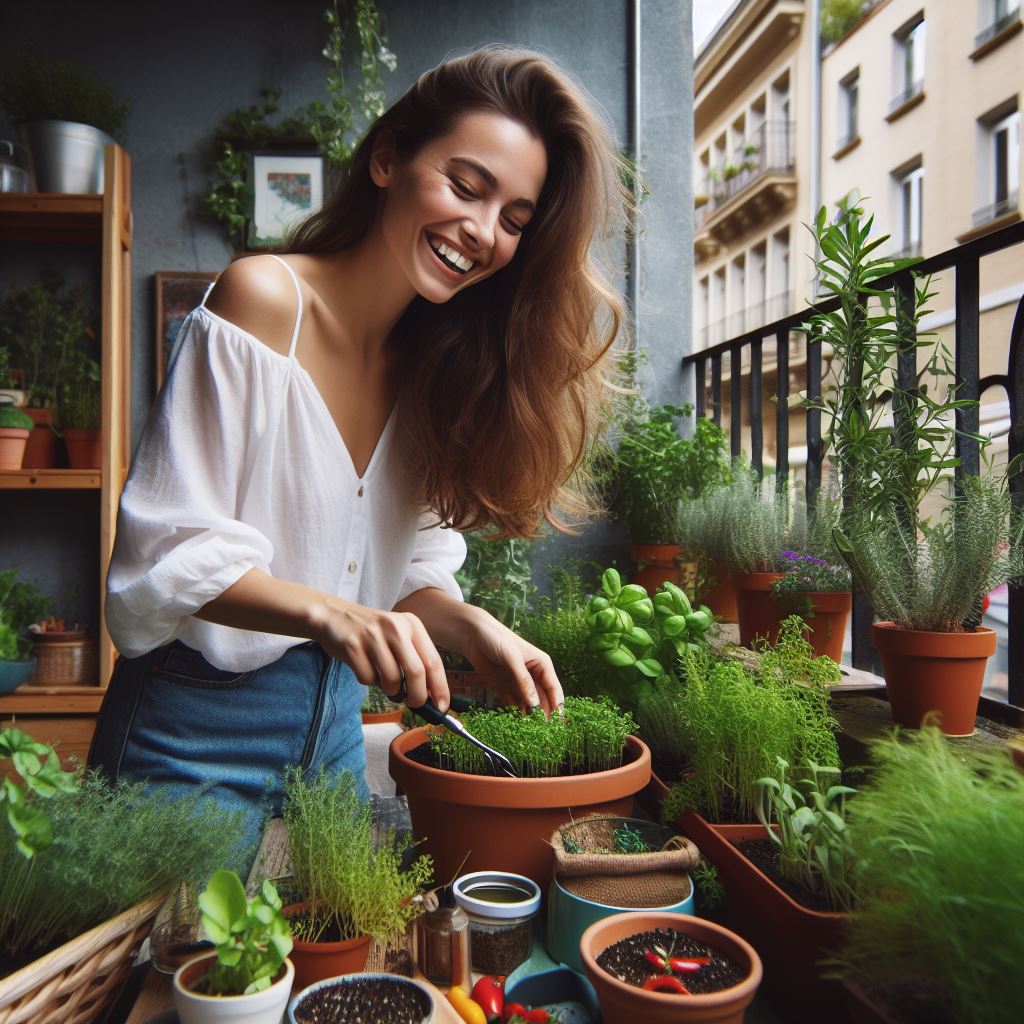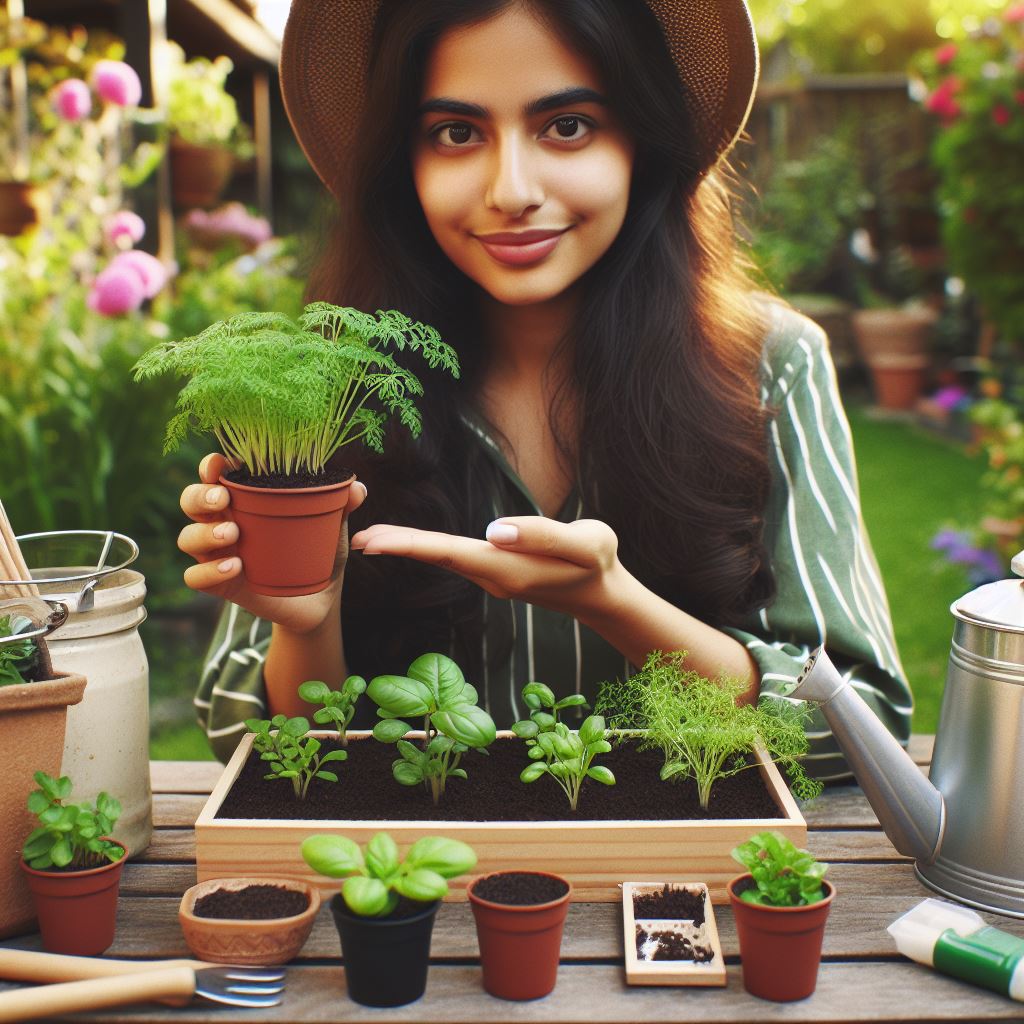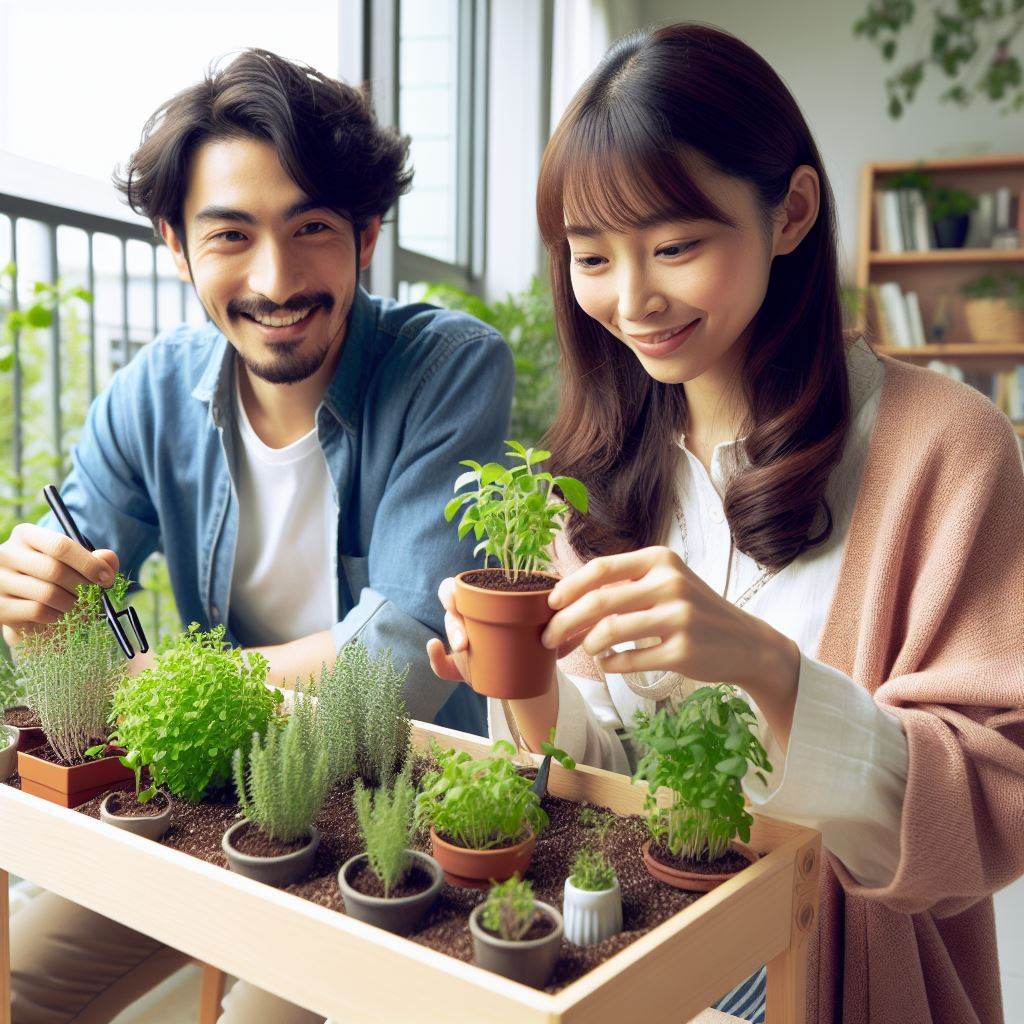Introduction
Herb gardening is a fantastic way to enhance the flavor and freshness of your meals.
With limited space, it can be challenging to cultivate a traditional garden.
However, herb gardening offers a solution for those with tiny yards.
This blog post will explore the benefits and importance of herb gardening, even in limited spaces.
The significance of herb gardening lies in the ability to have an abundant supply of fresh herbs at your disposal.
Herbs can elevate the flavors of your dishes, making them more vibrant and delicious.
Additionally, herbs are known for their numerous health benefits, such as boosting digestion and supporting the immune system.
For individuals with limited yard space, herb gardening is a game-changer.
Unlike traditional vegetable gardens, herbs require less space, making them perfect for tiny yards.
With the right containers and proper care, you can successfully grow a variety of herbs in a small area.
The purpose of this blog post is to provide practical tips and insights on how to create and maintain a thriving herb garden in a limited space.
From selecting the right herbs to choosing suitable containers, we will guide you through the entire process.
By the end of this post, you’ll be equipped with the knowledge and inspiration to embark on your own herb gardening journey, no matter how small your yard may be.
So let’s dive in and discover the wonders of herb gardening in tiny yards!
Choosing the Right Herbs for a Small Yard
Understanding the Growth Habits of Different Herbs
- Research and learn about the growth habits of various herbs to make informed choices.
- Consider the size and shape of each herb plant to ensure it fits well in a small yard.
- Some herbs, like mint and thyme, spread rapidly and may require containment to prevent overgrowth.
- Choose herbs that have a compact growth habit, like basil and rosemary, for limited spaces.
- Take into account the height of the herb plants and select ones that won’t overshadow other plants.
Considering Sunlight and Temperature Requirements
- Assess the amount of sunlight your small yard receives to determine the suitable herbs.
- Most herbs thrive in full sunlight, so choose varieties that require at least six hours of direct sun.
- If your yard has limited sunlight, opt for herbs like parsley, chives, and cilantro that tolerate shade.
- Take the local climate into account and choose herbs that can withstand the temperature extremes.
- Consider planting heat-tolerant herbs like oregano and thyme if your yard experiences hot summers.
Prioritizing the Most Commonly Used Herbs
- Determine the herbs you frequently use in cooking and prioritize them for your small yard.
- Consider versatile culinary herbs like basil, rosemary, and parsley that can enhance various dishes.
- Choose herbs that suit your culinary preferences and align with the flavors of your favorite recipes.
- If you enjoy herbal teas, prioritize herbs like chamomile, mint, and lemon balm in your selection.
- Prioritizing commonly used herbs ensures you get maximum utility from your small herb garden.
Creating a small herb garden in a tiny yard can be a rewarding and efficient way to add freshness and flavor to your cooking.
Transform Your Agribusiness
Unlock your farm's potential with expert advice tailored to your needs. Get actionable steps that drive real results.
Get StartedBy carefully choosing the right herbs, you can make the most of the limited space available and enjoy the benefits of having fresh ingredients at your fingertips.
Understanding the growth habits of different herbs
Understanding the growth habits of different herbs is crucial when selecting the plants for your small yard.
Conduct thorough research and learn about the characteristics of various herbs to make informed choices.
Consider the size, shape, and growth rate of each herb plant to ensure it fits well in your limited space.
Some herbs, like mint and thyme, have aggressive spreading habits, so it’s important to either plant them in containers or regularly prune and control their growth.
Considering Sunlight and Temperature Requirements
When choosing herbs for a small yard, it’s essential to consider their sunlight and temperature requirements.
Most herbs thrive in full sunlight, so assess the amount of sunlight your yard receives each day.
Opt for herbs that require at least six hours of direct sun to ensure healthy growth.
If your yard has limited sunlight, there are still options like parsley, chives, and cilantro that can tolerate shade.
Additionally, take the local climate into account and select herbs that can withstand the temperature extremes in your area.
Prioritizing the Most Commonly Used Herbs
Prioritizing the most commonly used herbs is a practical approach when dealing with limited space.
Determine the herbs you frequently use in your cooking and give them precedence in your herb garden.
Versatile culinary herbs like basil, rosemary, and parsley can be used in various dishes and provide a wide range of flavors.
Tailor your selection to suit your culinary preferences and align with the flavors of your favorite recipes.
If you enjoy herbal teas, consider including herbs like chamomile, mint, and lemon balm in your garden.
In general, when creating an herb garden in a small yard, it is important to choose the right herbs that fit the available space.
Understand the growth habits of various herbs, consider sunlight and temperature requirements, and prioritize the most commonly used herbs.
By carefully selecting and planting your herbs, you can create a thriving and bountiful herb garden even in the smallest of yards.
Read: Small Garden, Big Flavor: Growing Herbs Easily
Selecting the appropriate containers or gardening options
In order to successfully start an herb garden in a tiny yard, it is crucial to carefully select the right containers or gardening options.
Here are some factors to consider when evaluating different container materials:
Evaluating different container materials
When selecting the materials for your herb garden containers, it is important to consider their advantages and disadvantages.
- Clay containers: Clay containers are classic and allow for good airflow to the roots, preventing overwatering. However, they can dry out quickly and are prone to damage in freezing temperatures.
- Plastic containers: Plastic containers are lightweight, affordable, and retain moisture better than clay. However, they may not breathe as well, and if exposed to direct sunlight, they can degrade over time.
- Wood containers: Wood containers provide an excellent natural look and good insulation for herb roots. Make sure to choose untreated wood to avoid chemical leaching into the soil.
Exploring vertical gardening techniques
Vertical gardening is a creative and space-saving solution for herb lovers with limited yard space.
Here are some techniques to consider:
Showcase Your Farming Business
Publish your professional farming services profile on our blog for a one-time fee of $200 and reach a dedicated audience of farmers and agribusiness owners.
Publish Your Profile- Trellises: Trellises are great for growing climbing herbs like thyme, rosemary, and mint. They allow the herbs to grow vertically, using the vertical space efficiently.
- Hanging pots: Hanging pots are ideal for trailing herbs such as basil, oregano, and parsley. Hang them from a sturdy structure or use hanging plant hooks.
- Wall-mounted planters: Wall-mounted planters can transform any blank wall into a beautiful herb garden. They come in various sizes and designs, adding a decorative touch to your outdoor space.
Utilizing hanging baskets, window boxes, or wall-mounted planters
When space is limited, utilizing hanging baskets, window boxes, or wall-mounted planters can be a game-changer for your herb garden.
Here’s how you can make the most of these options:
- Hanging baskets: Hang your herb pots from a pergola, balcony railing, or tree branches. Ensure they receive adequate sunlight, as hanging plants may have limited access to direct sunlight.
- Window boxes: Window boxes are perfect for herbs that thrive in sunlight. Install them on your windowsills to take advantage of the available light and add beauty to your home’s exterior.
- Wall-mounted planters: Attach wall-mounted planters to fences, walls, or even indoors in your kitchen. This option saves space while allowing you to grow a variety of herbs within easy reach.
By selecting the appropriate containers or gardening options, you can create a thriving herb garden even in the smallest of yards.
Take advantage of vertical gardening techniques and utilize hanging baskets, window boxes, or wall-mounted planters to make the most of your space.
Read: Maximize Your Balcony: Top Herbs for Small Spaces
Preparing the soil
Assessing soil quality and drainage
Assessing the quality and drainage of the soil is crucial before starting your herb garden.
- Dig a small hole in various areas of your yard to examine the soil’s texture and composition.
- Look for signs of clay, sand, or silt, as well as any rocks or debris that could affect drainage.
- Poor drainage can lead to root rot, so ensure the soil is well-draining to provide a healthy environment.
Amending the soil with compost or organic matter
Amending the soil with compost or organic matter helps improve its fertility and structure.
- Add a generous layer of organic matter such as compost, aged manure, or leaf mold to the soil.
- Incorporate the organic matter by digging or tilling it into the top few inches of the soil.
- This will enhance its ability to retain moisture, provide nutrients, and promote beneficial microbial activity.
Soil pH requirements for different herbs
Understanding the soil pH requirements for different herbs is essential for optimal growth.
- Perform a soil pH test using a kit available at garden centers or by sending a sample to a testing laboratory.
- Most herbs prefer a slightly acidic to neutral soil with a pH range of 6.0 to 7.0.
- However, there are exceptions, like lavender and rosemary, which thrive in slightly alkaline soil with a pH of 7.0 to 8.0.
- Adjust the soil pH by adding amendments if necessary.
- For lowering pH, incorporate sulfur or iron sulfate into the soil. To raise pH, use lime or wood ashes.
- It’s important to note that certain herbs, like mint, can tolerate a wider pH range.
Creating raised beds for limited space
If you have limited yard space, creating raised beds is an excellent solution for herb gardening.
- Determine the ideal location for your raised beds, considering factors like sunlight and accessibility.
- Use materials such as wood, bricks, or concrete blocks to construct the raised beds.
- The raised beds should be at least 8-12 inches deep to provide ample root space for herbs.
- Fill the beds with a well-draining soil mix, combining equal parts of garden soil, compost, and perlite.
Companion planting for herbs
Companion planting can benefit your herb garden by enhancing growth, attracting pollinators, and repelling pests.
- Plant herbs that have similar water and sunlight requirements together to optimize their growth.
- Consider planting aromatic herbs like basil and chives to deter pests from attacking your other herbs.
- Marigolds can help deter aphids and attract beneficial insects such as ladybugs and lacewings.
In essence, properly preparing the soil is essential for successful herb gardening.
Assessing soil quality, amending it with organic matter, understanding pH requirements, creating raised beds, and practicing companion planting are all vital steps in creating a thriving herb garden in even the tiniest yards.
By following these guidelines, you can enjoy a bountiful herb garden and enhance the flavor of your culinary creations.
Read: Water-Efficient Plant Choices for Urban Farms

Planting and Caring for Herbs
Guidelines for Planting Herb Seeds or Seedlings
- Choose a location with adequate sunlight, at least 6 hours a day.
- Prepare the soil by removing weeds and adding organic matter for better drainage.
- Follow the seed packet instructions for the specific herb you’re planting.
- If using seedlings, dig a hole twice the size of the root ball and gently place the plant.
- Water the seeds or seedlings immediately after planting to ensure proper hydration.
Proper Spacing and Arrangement of Herbs
- Consider the mature size of each herb and plan for adequate spacing between plants.
- Some herbs like basil and parsley may require more space, while thyme and oregano can be planted closer together.
- Leave enough room for air circulation to prevent diseases and promote healthy growth.
- Group herbs with similar watering and sunlight requirements for easier maintenance.
Watering, Fertilizing, and Pruning Techniques for Optimal Growth
- Water herbs regularly, keeping the soil moist but not soaked. Avoid overwatering, which can lead to root rot.
- Mulching around the herbs helps retain moisture and prevents weed growth.
- Use organic fertilizers or compost to provide essential nutrients to the plants.
- Fertilize herbs sparingly, as they usually don’t require excessive feeding.
- Prune herbs regularly to encourage bushier growth and prevent them from becoming leggy.
- Pinch off the tips of the herbs to promote branching and increase foliage production.
- Remove any yellow or dead leaves to maintain the overall health of the plants.
- Harvest the herbs frequently to stimulate new growth and maintain their flavor and aroma.
- Avoid harvesting more than one-third of the plant at a time to ensure its continuous growth.
- Properly store harvested herbs by drying, freezing, or preserving them in oil or vinegar.
Now that you have learned the basics of planting and caring for herbs, you can start your own herb garden even in tiny yards.
Enjoy the process of watching your herbs flourish and reap the benefits of fresh flavors in your cooking!
Read: Innovative Gardening Gadgets for 2024
Effective Pest and Disease Management
Common pests that target herbs
- Aphids: Small insects that suck sap from plants, causing stunted growth and deformation.
- Slugs and snails: They feed on leaves, leaving large holes and slime trails.
- Whiteflies: Tiny white insects that suck sap, leading to leaf yellowing and wilting.
- Caterpillars: Larvae of butterflies and moths that chew on leaves and stems.
Natural methods to control pests, such as companion planting
- Planting garlic and onions near herbs deters aphids and other pests.
- Marigolds attract beneficial insects that prey on herb pests.
- Interplanting with herbs like basil and dill repels certain pests.
- Using homemade insecticidal soap made from water, soap, and oil can control pests.
Recognizing signs of diseases and applying preventive measures
- Fungal diseases: Look for powdery mildew, leaf spots, or wilting leaves.
- Bacterial diseases: Signs include wilting, leaf spots with water-soaked appearance, and rot.
- Viral diseases: Stunted growth, yellowing or mottling of leaves indicate viral infection.
- Preventive measures include proper spacing, good air circulation, and clean gardening tools.
- Watering the herbs in the morning to allow them to dry during the day minimizes disease spread.
Implementing effective pest and disease management strategies will ensure the health and productivity of your herb garden.
By identifying common pests that target herbs, you can take timely action to control their population and prevent damage.
Natural methods like companion planting can significantly reduce the need for chemical pesticides, making your garden environmentally friendly.
Additionally, recognizing signs of diseases and applying preventive measures will help keep your herbs disease-free.
Harvesting and Preserving Herbs
Knowing When to Harvest Herbs for Best Flavor and Aroma
- Harvest herbs in the morning after the dew has evaporated for maximum flavor and aroma.
- Pinch off the leaves or stems from the plant when they are at their peak flavor.
- Most herbs can be harvested multiple times during the growing season, allowing for continuous use.
Various Methods for Drying and Storing Herbs
- Air drying is the easiest and most common method for preserving herbs.
- Bundle a small amount of herbs together and hang them upside down in a well-ventilated area.
- Another drying method is to lay herbs in a single layer on a screen or paper towel.
- Herbs can also be dried in the oven by placing them on a baking sheet at a low temperature.
- Store dried herbs in airtight containers, away from direct sunlight, to maintain their flavor and freshness.
Creative Ideas for Using Freshly Harvested Herbs in Cooking and Crafts
- Infuse fresh herbs into oil or vinegar to create flavorful dressings and marinades.
- Add chopped herbs to homemade butter or cream cheese for a burst of flavor.
- Create herb-infused water by soaking herbs in a pitcher for a refreshing and fragrant beverage.
- Use freshly harvested herbs to make herb butters, which can be spread on bread or used for cooking.
- Incorporate herbs into homemade soaps or candles for a natural and aromatic touch.
- Dry herbs and create potpourri or sachets to add a pleasant scent to your home.
- Make herb-infused salts by grinding dried herbs with salt for a unique seasoning blend.
- Preserve herbs in ice cubes by placing chopped herbs in ice cube trays filled with water, then freezing.
- Add freshly harvested herbs to homemade bath products like bath salts or bath bombs for a spa-like experience.
In a nutshell, harvesting and preserving herbs are essential steps in maximizing their flavor and aroma.
By knowing when to harvest and using proper drying and storing methods, you can prolong the life of your herbs and enjoy their benefits for an extended period.
Additionally, incorporating freshly harvested herbs into your cooking and crafting endeavors adds a delightful and aromatic touch to your creations.
Embrace the world of herb gardening and explore the endless possibilities it offers for both your palate and creativity.
Conclusion
Recap of key points covered
In this Herb Gardening 101 guide, we covered the basics of designing, planting, and maintaining a thriving herb garden, even in the tiniest of yards.
We emphasized the importance of choosing the right herbs, preparing the soil, and providing the optimal sunlight and water.
We also discussed clever space-saving techniques like vertical gardening, container gardening, and companion planting to maximize your small outdoor area.
Additionally, we covered essential maintenance tasks like pruning, harvesting, and protecting your herbs from pests and diseases.
Encouragement for readers to start their own herb garden
Now that you have the knowledge, it’s time to get started!
Don’t let a small yard discourage you from enjoying the rewards of growing your own herbs.
With a little creativity and the right techniques, you can cultivate a thriving herb garden that adds flavor, aroma, and beauty to your outdoor space.
Start planning your layout, gather your supplies, and get your hands in the soil.
The satisfaction of harvesting fresh, homegrown herbs is truly unmatched.
Final thoughts on the benefits of herb gardening in tiny yards
Herb gardening in a tiny yard offers countless benefits beyond fresh produce.
It’s a therapeutic hobby that relieves stress, connects you with nature, and provides a sense of accomplishment.
It also adds visual interest and fragrance to your outdoor area, making it a more inviting and enjoyable space.
Don’t underestimate the power of a well-tended herb garden to transform even the smallest yard into a verdant oasis.




